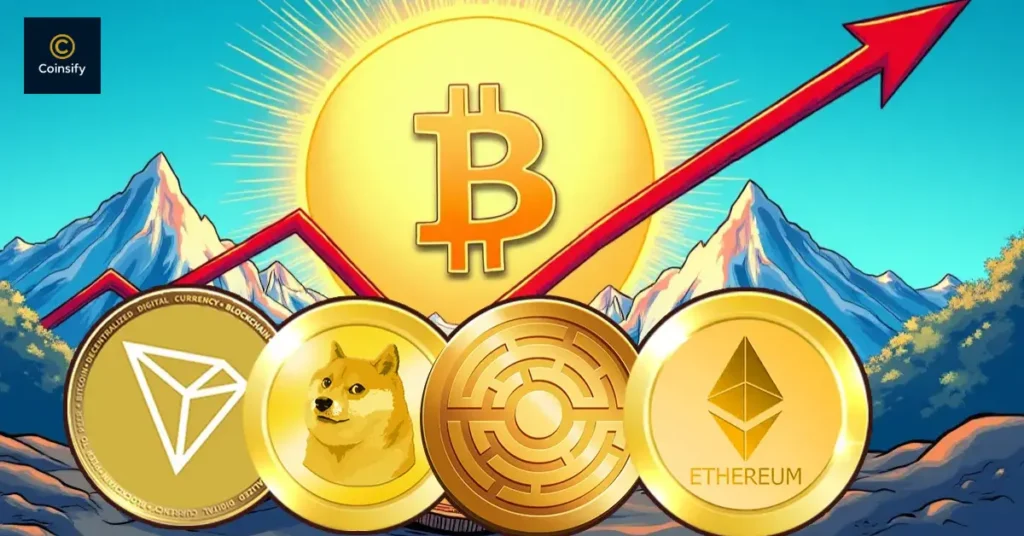Difference Between Bitcoin Ethereum and Altcoins
Introduction
The world of cryptocurrency can seem overwhelming, especially for newcomers. With thousands of digital assets circulating in the market, understanding the core differences between them is essential. At the center of this financial revolution are Bitcoin, Ethereum, and a broad group known as Altcoins.
Each of these plays a unique role in the crypto ecosystem. While Bitcoin is often viewed as digital gold, Ethereum introduces powerful technology like smart contracts. Altcoins, meanwhile, represent all the other coins that aim to improve upon or offer alternatives to Bitcoin and Ethereum.
In this blog, we’ll break down the fundamental differences between these major types of cryptocurrencies in a simple, easy-to-understand way. Whether you’re an investor, a tech enthusiast, or just curious, this guide will help you make sense of the crypto landscape.
Bitcoin: The Original Cryptocurrency
Bitcoin is the first and most well-known cryptocurrency in the world. It was introduced in 2009 by an anonymous individual or group using the name Satoshi Nakamoto. The idea behind Bitcoin was to create a decentralized digital currency that allows people to send money directly to one another—without needing a bank or any third-party intermediary.
Purpose of Bitcoin
Bitcoin was designed as a peer-to-peer electronic cash system. Its primary goal is to give people full control over their money and to offer an alternative to traditional banking systems. Unlike fiat currencies, which are controlled by governments and central banks, Bitcoin operates on a public and transparent network managed by users around the world.
How It Works
Bitcoin transactions are recorded on a blockchain, which is a public digital ledger. When someone sends Bitcoin, that transaction is verified by network participants called miners, who solve complex mathematical problems to confirm and add the transaction to the blockchain. This process is called Proof of Work (PoW).
Key Features of Bitcoin:
- Decentralized: No central authority controls it.
- Limited Supply: Only 21 million Bitcoins will ever exist, making it a scarce digital asset.
- Secure and Transparent: Every transaction is publicly recorded and cannot be changed.
- Store of Value: Often compared to digital gold due to its long-term value potential.
Bitcoin laid the foundation for the entire cryptocurrency industry. It introduced the world to the idea that money can exist and operate without banks or governments. Although new technologies have emerged since its creation, Bitcoin continues to be the most dominant and influential cryptocurrency to this day.
Ethereum: More Than Just a Currency
While Bitcoin introduced the concept of decentralized money, Ethereum expanded the idea by offering a programmable blockchain. Launched in 2015 by Vitalik Buterin, Ethereum was designed to do much more than just transfer value — it enables developers to build applications directly on its network.
The Purpose Behind Ethereum
Ethereum was created to be a platform for decentralized applications (dApps) and smart contracts. Instead of just sending and receiving digital coins, users can run code on the blockchain — code that automatically executes based on predefined rules, without human intervention or central control.
What Are Smart Contracts?
Smart contracts are one of Ethereum’s most powerful features. These are self-executing agreements with the terms directly written into code. Once deployed, they run exactly as programmed, reducing the risk of fraud or manipulation.
For example, a smart contract could automatically release payment once a service is completed — no middlemen, no delays, and no disputes.
Decentralized Applications (dApps)
Ethereum allows developers to build and deploy dApps — applications that run on a decentralized network instead of centralized servers. These apps can range from finance (like lending platforms) to gaming, social media, and even supply chain tracking.
Ether (ETH): The Native Token
Ethereum’s native cryptocurrency is called Ether (ETH). While it can be used as a digital currency like Bitcoin, it also powers everything on the Ethereum network — from paying transaction fees to executing smart contracts.
How Ethereum Differs from Bitcoin
| Feature | Bitcoin | Ethereum |
| Main Purpose | Digital currency | Platform for dApps and smart contracts |
| Currency Name | Bitcoin (BTC) | Ether (ETH)Launch Year |
| Launch Year | 2009 | 2015 |
| Smart Contracts | No | Yes |
| Flexibility | Limited | Highly programmable |
Ethereum is often seen as the next step in the evolution of blockchain technology. By enabling programmable money and decentralized services, it opened the door to new innovations in finance, governance, and digital ownership.
Altcoins: The Rest of the Crypto World
Once Bitcoin and Ethereum paved the way, thousands of other cryptocurrencies followed. These are known as Altcoins, short for “alternative coins.” Simply put, altcoins include any cryptocurrency other than Bitcoin — and in most cases, Ethereum as well.
Some altcoins aim to improve on Bitcoin’s technology, while others offer entirely new features, use cases, or specialized purposes within the blockchain space.
Why Do Altcoins Exist?
Altcoins were created to solve problems or add features that Bitcoin and Ethereum may not address fully. For instance, some focus on faster transaction speeds, lower fees, better energy efficiency, or specific applications like private payments or decentralized storage.
Each altcoin has its own blockchain (or runs on another blockchain like Ethereum), its own purpose, and its own token economics.
Examples of Popular Altcoins
Here are a few well-known altcoins and what makes them different:
- Litecoin (LTC): Designed to be the “silver” to Bitcoin’s “gold,” Litecoin offers faster transaction times and lower fees.
- Ripple (XRP): Focuses on enabling fast, low-cost international money transfers, especially for banks and financial institutions.
- Cardano (ADA): Built on a research-driven approach, Cardano aims to offer secure and scalable smart contracts.
- Solana (SOL): Known for high-speed transactions and low costs, often used in NFT and DeFi applications.
- Polkadot (DOT): Enables multiple blockchains to work together and share information, promoting interoperability.
Different Categories of Altcoins
Altcoins can be grouped into various categories based on their purpose:
Stablecoins
- Pegged to fiat currencies like the US Dollar to maintain a stable value.
- Example: USDT (Tether), USDC (USD Coin)
Utility Tokens
- Used to access services within a specific blockchain project.
- Example: BNB (used on Binance ecosystem)
Security Tokens
- Represent ownership in real-world assets, like stocks or property, on the blockchain.
Governance Tokens
- Allow holders to vote on protocol decisions, such as software upgrades or policy changes.
- Example: UNI (Uniswap), MKR (MakerDAO)
Meme Coins
- Created more for community and fun, often without a serious use case.
- Example: Dogecoin (DOGE), Shiba Inu (SHIB)
What to Know About Altcoins
- Not all altcoins are valuable or successful — some are experimental, while others are speculative.
- Altcoins usually have higher risk and volatility than Bitcoin or Ethereum.
- However, they also offer potential for innovation and growth in specific niches.
Altcoins are a critical part of the evolving crypto ecosystem. While Bitcoin and Ethereum lead in market value and recognition, altcoins bring diversity, competition, and innovation to the blockchain space.
Key Differences Between Bitcoin, Ethereum, and Altcoins
Understanding how Bitcoin, Ethereum, and Altcoins differ is essential for anyone interested in the cryptocurrency space. While they all operate on blockchain technology, they serve different purposes, use different systems, and have varying strengths and weaknesses.
Below is a breakdown of the key differences to help clarify how these crypto assets stand apart:
Purpose and Primary Use Case
Bitcoin:
- Created as a decentralized digital currency, its main function is to serve as a store of value and medium of exchange. Often referred to as “digital gold,” Bitcoin focuses purely on financial transactions.
Ethereum:
- Goes beyond currency. It was designed as a platform for decentralized applications and smart contracts. Ethereum supports a wide range of uses in finance, gaming, NFTs, and more.
Altcoins:
- These vary widely in purpose. Some aim to improve on Bitcoin or Ethereum, while others are designed for specific tasks—like private transactions, fast payments, or decentralized governance.
Technology and Blockchain Structure
Bitcoin:
- Uses a Proof of Work (PoW) mechanism, making it secure but slower and more energy-intensive. It has limited functionality beyond simple transactions.
Ethereum:
- Initially launched with PoW but is transitioning to Proof of Stake (PoS) under Ethereum 2.0. It supports complex programming logic through smart contracts.
Altcoins:
- Come in many forms. Some use PoW or PoS, others use hybrid systems or unique models like Delegated Proof of Stake (DPoS) or Proof of Authority (PoA). Technical innovation is common among altcoins.
Flexibility and Innovation
Bitcoin:
- More conservative in development to preserve stability and security. Limited changes are made over time.
Ethereum:
- Highly flexible and designed for growth. It frequently undergoes updates to improve scalability and performance.
Altcoins:
- Often serve as experimental platforms. Many introduce cutting-edge features such as faster block times, privacy enhancements, or novel governance models.
Market Position and Community Support
Bitcoin:
- The first and most valuable cryptocurrency by market cap. It has the widest adoption and strongest brand recognition.
Ethereum:
- The second-largest crypto asset. It’s dominant in the areas of decentralized finance (DeFi) and NFTs, with a massive developer community.
Altcoins:
- Include thousands of projects. Some, like Binance Coin or Solana, have built strong ecosystems, while others may lack stability or long-term potential.
Supply and Economic Model
Bitcoin:
- Has a fixed maximum supply of 21 million coins, which contributes to its scarcity and appeal as a hedge against inflation.
Ethereum:
- Does not have a hard cap on supply, though recent updates aim to reduce inflation over time by burning a portion of transaction fees.
Altcoins:
- Supply varies depending on the project. Some have limited supply like Bitcoin, while others continuously mint new coins or tokens.
Comparison Table
| Feature | Bitcoin | Ethereum | Altcoins |
| Launch Year | 2009 | 2015 | Varies |
| Primary Purpose | Digital currency | Decentralized platform | Depends on the coin |
| Consensus Mechanism | Proof of Work (PoW) | Transitioning to Proof of Stake | PoW, PoS, DPoS, others |
| Smart Contracts Support | No | Yes | Some support, others do not |
| Supply Limit | 21 million | No fixed cap | Varies |
| Flexibility | Low | High | Depends on the project |
| Market Position | First and most valuable | Second-largest and growing | Competitive and diverse |
Each type of cryptocurrency brings something different to the table. Whether you value security and simplicity (Bitcoin), innovation and application (Ethereum), or variety and niche solutions (Altcoins), your choice will depend on your goals and interests in the crypto space.
Frequently Asked Questions (FAQs)
What is the main difference between Bitcoin and Ethereum?
Bitcoin is mainly used as a digital currency — a way to send and store money.
Ethereum, on the other hand, is more than a currency. It is a platform for building apps and smart contracts that run on blockchain technology.
What are Altcoins?
Altcoins are all other cryptocurrencies except Bitcoin. Some people also exclude Ethereum from this category. Altcoins can have different features, purposes, and technologies.
Is Ethereum better than Bitcoin?
Not necessarily — they have different goals. Bitcoin is great for storing and transferring value. Ethereum is ideal for building applications and running smart contracts. Each has its own strengths.
Are Altcoins safe to invest in?
Some altcoins are well-developed and trusted, but many are risky or experimental. Always do your own research before investing. Look at the project’s use case, team, and community support.
Why are there so many cryptocurrencies?
There are thousands of cryptocurrencies because developers are trying different ideas. Some aim to improve Bitcoin or Ethereum, while others focus on new features like privacy, speed, or specific industries.
What is a smart contract?
A smart contract is a piece of code that runs on the blockchain. It automatically executes actions (like sending money) when certain conditions are met — without needing a middleman.
Can I use Ethereum like Bitcoin to send money?
Yes, you can use Ethereum (ETH) to send and receive payments, just like Bitcoin. However, its main strength is powering applications, not just handling transactions.
Which is more valuable: Bitcoin or Ethereum?
As of now, Bitcoin is more valuable in terms of market price and recognition. But Ethereum has a broader range of use cases in the tech world. Both are important in their own ways.
What should I invest in: Bitcoin, Ethereum, or Altcoins?
- It depends on your goals and risk level.
- Bitcoin is usually seen as more stable.
- Ethereum offers more functionality.
- Altcoins may offer high rewards but also high risk.
- Always research and consider diversifying before investing.
Do I need to buy a whole Bitcoin or Ethereum coin?
No, you can buy a fraction of a Bitcoin or Ethereum. For example, you can buy 0.01 BTC or 0.05 ETH, depending on your budget.
Conclusion
Bitcoin, Ethereum, and Altcoins each play a unique role in the world of cryptocurrency. Bitcoin is the first and most trusted digital currency. Ethereum takes things further by allowing developers to build apps and smart contracts. Altcoins bring even more variety and innovation to the space.
Understanding these differences helps you make better decisions, whether you’re investing, learning, or just exploring the crypto world. Start small, do your research, and stay informed as this exciting technology continues to grow.
Also read
- What is a Crypto Wallet and How Does It Work? – Coinsify
- 10 Crypto Terms Every Beginner Must Know – Coinsify
- What is Blockchain Technology – Complete Guide – Coinsify
- How to Buy Crypto Safely in 2025 – Complete Guide – Coinsify
- Bitcoin vs Ethereum: Key Differences Explained – Complete Guide
- Ultimate Blockchain Glossary: Learn Blockchain Terms Easily
- How to Buy Bitcoin Safely (Complete Beginner’s Guide)
- Top 10 Crypto Wallets for Beginners (2025 Edition)
- What is Cryptocurrency? A Beginner-Friendly Guide (2025)






